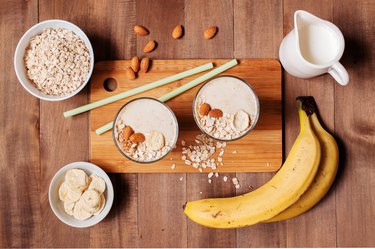
When you have diabetes, you need to find a protein shake that fits your diet plan and doesn't cause your blood sugar to spike. Meal replacement shakes don't provide all the nutrients your body needs and shouldn't be your only source of nutrition, but they may work occasionally (not every day) on busy days or when you're on the go.
While it's always a smart idea to talk to your doctor or a registered dietitian about your individual nutrition needs, here are some helpful details to know about protein shakes and diabetes.
Video of the Day
Video of the Day
Protein Intake and Blood Sugar
Protein is an important nutrient made up of building blocks called amino acids. Although protein is one source of energy for the body, it also plays a vital role in the growth and development of every single cell.
Foods high in protein — like chicken breast, fish and eggs — don't generally contain much sugar, so they usually don't have much of an effect on your blood sugar, according to the Joslin Diabetes Center.
But shakes are a different story: Store-bought varieties can be high in added sugars and carbs. So if you're managing diabetes you need to read protein shake nutrition labels carefully.
Benefits of Protein Shakes for Diabetes
Low-sugar protein shakes can be a nutritious option for people living with diabetes for a number of reasons:
- They're convenient: Bottled shakes (or even a shake recipe you make at home and take with you) provide protein and other nutrients during a hectic day when you might not have time to prepare a balanced meal.
- They could help support weight loss: Protein can help you reach a weight-loss goal, likely because protein is satisfying and keeps you feeling fuller longer. Getting enough of this vital nutrient is linked with reduced appetite, better body-weight management and lower risk of cardiometabolic health conditions, according to a June 2015 article in the American Journal of Clinical Nutrition.
- They might help regulate blood sugar: While more research is needed to truly understand the link between dietary protein and diabetes, eating protein with carbs can help slow the absorption of sugar and keep blood glucose more stable, according to Mass General Brigham hospital.
How Much Protein Do You Need?
The general recommendation is to get about 0.8 grams of protein per kilogram of your body weight per day. A kilogram is 2.2 pounds. So, for a 185-pound person, that's about 67 grams of a protein a day.
But if you're trying to lose weight or build muscle, you could most likely benefit from more, according to a December 2019 study in Advances in Nutrition. Instead, aim for 1.3 grams of protein per kilogram of body weight per day. For that same 185-pound person, that's 109 grams of protein a day.
Protein Shake Options for People With Diabetes
Some protein shakes specifically designed for people with diabetes contain fiber and resistant starch, forms of carbohydrates that are broken down much more slowly in your body (if they are broken down at all), so they don't spike your glucose as much as simple sugars.
Some examples of protein shakes formulated specifically for glycemic control include:
You can also buy diabetes-friendly protein powder like Extend Nutrition ($23.99, Amazon) and mix it up with your own ingredients at home (more on that below).
What to Look for in a Protein Shake
Whether you're buying protein powder to make your own shake or a packaged protein shake, keep the following in mind.
- No added sugar: Sugar shouldn't be listed as one of the first three ingredients, according to the Cleveland Clinic.
- Low in carbs: You also want the total carbohydrate count to be low, ideally between 5 and 15 grams per serving, per the Cleveland Clinic.
- Moderate calories: Per serving, your shake should have about 100 to 200 calories, according to the Mayo Clinic.
- Third-party testing: Supplements like protein powders aren't regulated as strictly as prescription meds by the FDA. Look for seals on the labels of your products that they've been vetted for quality by third-party organizations like by USP, NSF or Consumer Labs.
- Meets your needs: Protein shakes and powders can be made from different sources, such as whey, casein or pea protein. Make sure you're checking the ingredients against any dietary preferences, intolerances or allergies you have. Learn more about how to pick the best protein powder for your goals.
Diabetes-Friendly Protein Shake Recipes
Making your own protein shake using whole foods can be even more nutritious than buying a bottled shake.
For example, this recipe would contain 15 grams of protein, 35 grams of carbs and 255 calories. Blend:
- One small banana
- 1/2 cup whole strawberries
- 1/2 cup soft tofu
- 1 cup nonfat milk
- Ice
Tip
Add protein powder for even more protein. And consider adding a little fat like peanut butter or flaxseeds to help slow the digestion of your shake and help improve blood sugar control.
- Joslin Diabetes Center: "Carbs, Protein and Fats – Their Effect on Glucose Levels"
- Mass General Brigham: "How to Control Blood Sugar With Diet"
- AJCN: "The role of protein in weight loss and maintenance"
- Advances in Nutrition: "Protein Intake Greater than the RDA Differentially Influences Whole-Body Lean Mass Responses to Purposeful Catabolic and Anabolic Stressors: A Systematic Review and Meta-analysis"
- Cleveland Clinic: "How to Choose the Best Protein Powder for You"
- Mayo Clinic: "Guidance on Selecting Protein Powders, Shakes, and Bars"